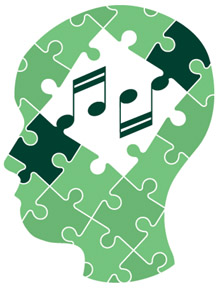Neuroscience Advancements in Music Therapy

As music is primarily processed in the brain, emerging music therapy literature explores the effects of music on the brain.
New research shows the advancement in shared neural systems between musical cognition and non-musical cognitive functions (Thaut, 2010). That is, music therapy affects cognitive rehabilitation of non-musical cognitive functions such as memory, attention, emotional adjustment and executive functions (Thaut, 2010).
This developing area of research is referred to as Neurlogic Music Therapy (NMT), and is defined as, “ the therapeutic application of music to cognitive, sensory, and motor function due to neurologic disease of the human nervous system” (CSA). NMT is based on the notion that music is a cognitive and perceptual language that stimulates the brain and prompts brain and behavioural functions (Peretz & Zatorre, 2005; Purdie, 1997; Zatorre, 2003, 2001).
General music therapy treats emotional, physical and mental needs, whereas, NMT focuses on the physical affects that music (and its rhythms) has on the brain and neuropathways (NMTSA). NMT is said to be able to build new new brain connections, thus improving brain function and quality of life (NMTSA). Simply said, NMT is an advanced form of music therapy, focusing on scientific techniques.
Like general music therapy, NMT techniques vary pending on the client’s needs, abilities, and goals. For instance, speech clients may sing, and clients wanting to improve motor skills may play drums. However, in general music therapy sessions, the clinician aims to better focus, and communications; whereas, with in NMT, the clinician aims to interpret how the client uses musical rhythm’s to perform the task.
NMT can benefit those who suffer from neurological disorders, and/or those whose therapeutic goals are to improve sensory-motor functions, speech and language, and cognitive functioning.
Sources:
Peretz, I. & R.J. Zatorre. (2005). Brain organization for music processing. Annu. Rev. Psychol. 56: 89–114.
Purdie, H.(1997). Music therapy™ in neurorehabilitation: recent developments and new challenges. Crit. Rev. Phys. Rehabil. Med.9: 205–217.
Thaut, Michael H. (2010). Neurologic Music Therapy in Cognitive Rehabilitation. Music Perception: An Interdisciplinary Journal, Vol. 27, No. 4, pp. 281-285.
Zatorre, R.J. (2001). Neural specializations for tonal processing. Ann. N. Y. Acad. Sci.930: 193–210.
Zatorre, R.J.(2003). Music and the brain. Ann. N. Y. Acad. Sci.999: 4–14.


Hi, thanks for sharing. I’m wondering if it’s OK to copy some of the text in my site?
Hi Bill
Thanks for your very useful article about the differences between NMT and general music therapy. I wonder, however, whether GMT isn’t also building neural pathways in addition to its emotional benefits etc, so perhaps the differences between the 2 aren’t that great after all?
I think you could be right, Jasmine; but hey they both work, which is great!